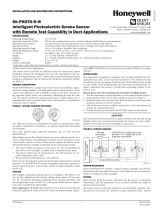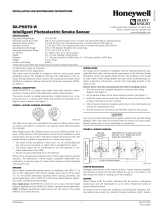
2151/2151T Low Prole
Photoelectronic Plug-in
Smoke Detectors
INSTALLATION AND MAINTENANCE INSTRUCTIONS
3825 Ohio Avenue, St. Charles, Illinois 60174
1-800-SENSOR2, FAX: 630-377-6495
www.systemsensor.com
BEFORE INSTALLING
Please thoroughly read System Sensor’s Applications Guide for System Smoke
Detectors (SPAG91), which provides detailed information on detector spacing,
placement, zoning, wiring, and special applications. This manual is available
online at www.systemsensor.com.
NOTICE: This manual should be left with the owner/user of this equipment.
IMPORTANT: The detector must be tested and maintained regularly following
NFPA 72 requirements. The detector should be cleaned at least once a year.
GENERAL DESCRIPTION
The 2151 low-profile photoelectronic detector uses a state-of-the-art optical
sensing chamber. This detector is designed to provide open area protection
and to be used with compatible UL listed control panels only. The capability
of plugging this detector into a variety of special bases makes it more versatile
than equivalent direct-wired models.
Two LEDs on each detector provide local 360° visible alarm indication. They
flash every five seconds indicating that power is applied and the detector
is working properly. The LEDs latch on in alarm. LEDs will be off when a
trouble condition exists indicating that the detector sensitivity is outside the
listed limit. Remote LED annunciator capability is standard and may be imple-
mented through an optional accessory RA400Z/RA100Z. The alarm can be
reset only by a momentary power interruption. This detector may be tested by
activating the internal reed switch with a magnet.
BASE SELECTION AND WIRING GUIDE
Refer to the installation instructions for the Plug-in Detector Bases for base se-
lection and wiring instructions. System Sensor has a variety of detector bases
available for this smoke detector, including 2-wire applications with and with-
out relays and/or current limiting resistors, 4-wire and 120VAC applications.
All bases are provided with screw terminals for power, ground, remote an-
nunciator connections and relay contact connections, if applicable. The elec-
trical ratings for each detector-base combination are also included in the base
installation instructions.
INSTALLATION
NOTE: All wiring must conform to applicable local codes, ordinances, and
regulations.
NOTE: Verify that all detector bases are installed, that the initiating-device
circuits have been tested, and that the wiring is correct. (Refer to detector base
manual for testing procedure.)
Remove power from initiating-device circuits before installing detectors.
1. Install detectors:
a. Place the detector into the detector base.
b. Turn the detector clockwise until the detector drops into place.
c. Continue turning detector clockwise to lock it in place.
2. Tamper Resistance: The detector bases can be made tamper resistant.
SPECIFICATIONS
Size
Height: 2.0 inches (51 mm) installed in B401 Base
Diameter: 4.1 inches (104 mm) installed in B401 Base
6.1 inches (155 mm) installed in B110LP Base
Weight: 3.1 oz. (88 g)
Operating Temperature Range: 0°C to 49°C (32°F to 120°F); 2151,0°C to 38°C (32°F to 100°F); 2151T
Operating Humidity Range: 10% to 93% Relative Humidity noncondensing
Heat Sensor (2151T only): 135°F Fixed Temperature Electronic Thermistor
Operating Voltage: 8.5 to 35VDC
Standby Current: 120µA
Latching Alarm: Reset by momentary power interruption.
When capability is enabled, detectors cannot be removed from the base with
-
out the use of a tool. See the detector base installation manual of the detector
base for details in using this capability.
3. After all detectors have been installed, apply power to the control unit.
4. Test the detector using the magnet as described under TESTING.
5. Reset the detector at the system control panel.
6. Notify the proper authorities that the system is back on line.
TESTING
Before testing, notify the proper authorities that the smoke detector system is
undergoing maintenance and will temporarily be out of service. Disable the
zone or system undergoing maintenance to prevent unwanted alarms. Detec-
tors must be tested after installation and as part of periodic maintenance. Test
2151 and 2151T as follows:
NOTE: Before testing the detector, check to ensure the LEDs blink. If they
do not, the detector has lost power (check the wiring), it is defective (return
it for repair), or the detector sensitivity is outside the listed limits.
A. Test Magnet (p/n M02-04-01 or M02-09-00)
1. Place the magnet against the cover in the location designated by the
raised mark to activate the test feature (see Figure 1).
2. The LEDs should latch ON within 5 seconds indicating alarm and an-
nunciating the panel.
B. Test Module (SENS-RDR)
Use the SENS-RDR Sensitivity Reader to measure the sensitivity of the detec-
tors. Please refer to the SENS-RDR instruction manual for operating details.
C. Smoke Entry
The GEMINI model 501 aerosol generator can be used for smoke entry
testing. Set the generator to represent 4%/ft to 5%/ft obscuration as de-
scribed in the GEMINI 501 manual. Using the bowl shaped applicator,
apply aerosol until the panel alarms.
Additionally, canned aerosol simulated smoke (canned smoke agent)
may be used for smoke entry testing of the smoke detector. Tested and
approved aerosol smoke products are:
MANUFACTURER MODEL
Home Safeguard Industries 25S
SDi CHEK02 and CHEK06
SDi SOLOA4
SDi SMOKESABRE-01
When used properly, the canned smoke agent will cause the smoke detector
to go into alarm. Refer to the manufacturer’s published instructions for proper
use of the canned smoke agent.
I56-2806-007R
1 I56-2806-007R
06-10






